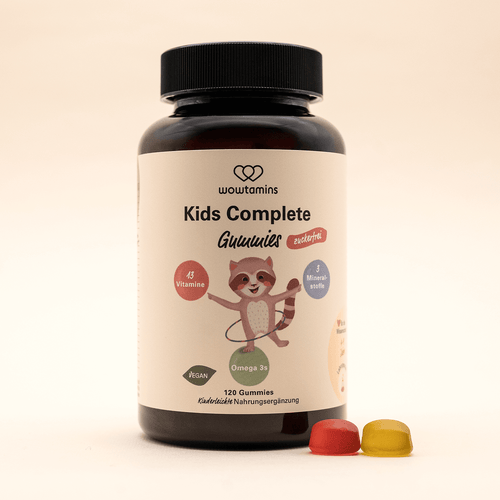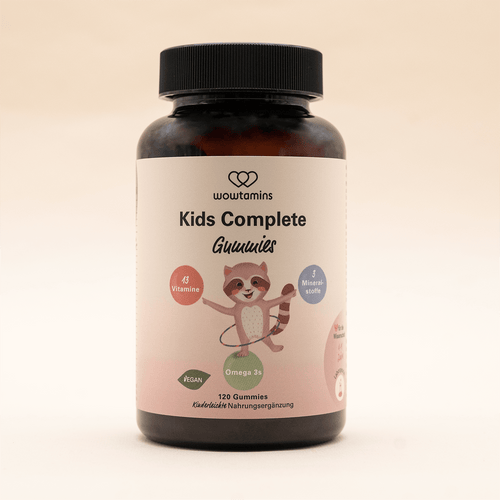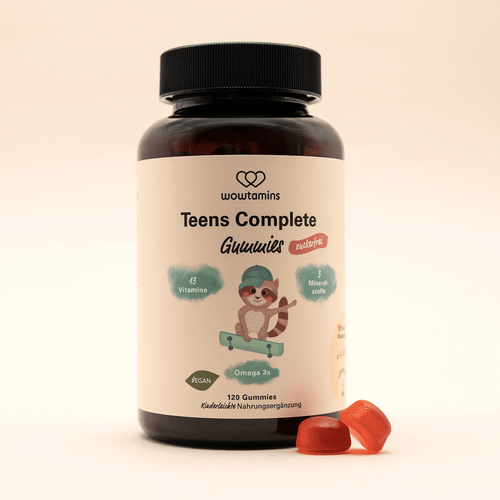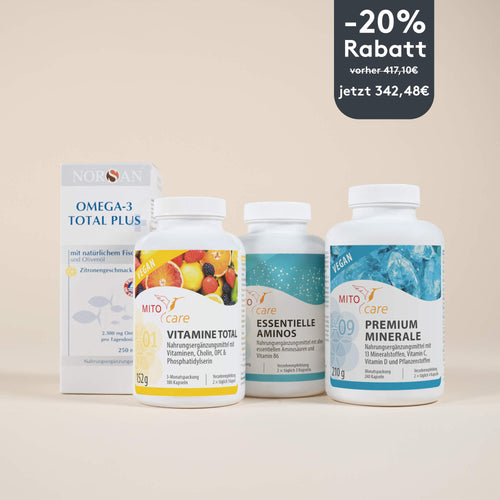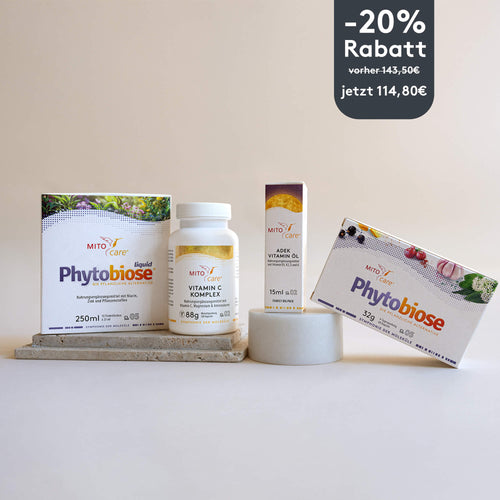Themen dieses Blogartikels:
Introduction
Micronutrients such as vitamins, minerals, trace elements, omega-3 fatty acids, and secondary plant compounds make a crucial contribution to our health. The term "micronutrients" refers to essential nutrients that our body needs in small amounts, but which have a significant impact on our health and well-being. However, it is not enough to simply take supplements indiscriminately, as the influence of micronutrients on health is significant. Rather, these substances should be combined effectively, timed correctly, and used in moderate doses so that they work optimally and do not block each other.
Micronutrients are found in almost everything we consume and therefore play a central role in our daily diet. This comprehensive guide explains important combination rules, describes favorable times for intake, and points out typical mistakes in parallel supplementation. This way, you get the maximum benefit from your diet and nutritional supplements – without overdoses or absorption blockages.
Tips for Combining Active Ingredients
Classic: Collagen + Vitamin C – Cofactor for stable structures
Collagen supplements are popular for skin, hair, nails, and joints. However, without the right environment, the body cannot optimally utilize this structural protein.Vitamin C acts as an important cofactor for the two enzymes prolyl- and lysyl-hydroxylase, which are responsible for the hydroxylation of proline and lysine residues in collagen.¹ Only through this reaction can stable cross-links form, giving collagen fibers their tensile strength. Therefore, vitamin C is an important cofactor for the formation and stabilization of collagen fibers. In human skin fibroblasts, vitamin C even increases the production of collagen-related mRNA.²
A lack ofvitamin C therefore leads to reduced collagen production and fragile skin. The body can be compared to a factory where micronutrients like vitamin C act as diligent workers, ensuring that all processes run smoothly. Therefore, always combine collagen peptides or gelatin with a vitamin C source – this can be a supplement, but also a glass of freshly squeezed orange juice. Combination products that also contain silicon and hyaluronic acid are particularly effective. Silicon supports the formation of collagen and elastin, while hyaluronic acid binds large amounts of water, thus plumping up the connective tissue.
Fat-soluble vitamins (A, D, E, K) + oil – Lipophilic nutrients require fat
The fat-soluble vitamins A, D, E, and K are absorbed via the same transport pathways as dietary lipids. They are lipophilic and poorly soluble in water. The formation of micelles in the small intestine, which encapsulate fat-soluble molecules, is stimulated by the presence of dietary fats. Without these fat droplets, ADEKs are insufficiently absorbed into the enterocytes.


Macronutrients such as fats, carbohydrates, and proteins are the main energy suppliers for the body and are called macronutrients because they are needed in larger quantities. In contrast, micronutrients such as vitamins and minerals perform supporting functions in the body and, as helpers, ensure that biochemical processes function smoothly.
Ideally, therefore, vitamin D drops, vitamin K capsules or combination products should be taken with a small amount of high-quality oil (e.g. olive oil or linseed oil) – for example, with a meal that also contains omega-3 fatty acids. This increases bioavailability and ensures a consistent supply. Important to know: For vitamin D to be able to incorporate calcium and not accumulate in the blood, the body needs vitamin K2 in addition to sufficient magnesium; both regulate the transport of calcium into the bones (see here) .
Polyphenols + Oils – Synergy of Antioxidants & Omega-3
Polyphenols such as flavonoids or phenolic acids are strong antioxidants and often have a lipophilic end. When taken together with omega-3-containing oils , they protect the sensitive fatty acids from oxidative degradation. Studies show that the combination of polyphenols and fish oil improves the bioavailability of both groups of substances. Lipophilic polyphenols increase the absorption of omega-3 fatty acids and reduce their oxidation, while omega-3 fatty acids improve the cell penetration of polyphenols.³ Thus, the two groups of substances help each other. Especially with fatty acids that are quickly susceptible to oxidation, such as EPA and DHA from algae or fish oil, the additional intake of natural polyphenols from olive oil, grape seed extract or green tea is worthwhile.
Advertisement
- 2-in-1 blend of olive oil & algae oil
- Combines the important fatty acids DHA & EPA from plant-based algae oil.
- Daily dose with 800mg DHA & 450mg EPA in a 2:1 ratio
- Plant-based & sustainable alternative to fish oil
- Mild flavor for integration into cold dishes
- Without fillers or flavorings
- Developed with doctors & experts
- Vegan & vegetarian

Iron + Vitamin C – better absorption through reduction
Iron from plant-based sources (non-heme iron) is less readily available than heme iron from animal meat. In the acidic stomach environment, it is predominantly present as trivalent iron (Fe³⁺), which is poorly absorbed by the iron transporters of the intestinal cells. Vitamin C forms a soluble chelate with Fe³⁺ and reduces it to its divalent form (Fe²⁺).⁴
This significantly increases iron absorption in the intestines : According to studies, a dose of 25–1000 mg of vitamin C per meal can increase the absorption of non-heme iron from 0.8% to up to 7.1%.⁴
In doing so, vitamin C converts iron into a more soluble form, thus increasing the bioavailability of iron and therefore the overall iron absorption. Therefore, in cases of proven iron deficiency or a vegetarian diet, iron should always be consumed together with vitamin C. Those taking tablets should choose a time on an empty stomach in the morning or with a vitamin C-rich snack.
B vitamins (B6, B9 & B12) – a team working together in homocysteine metabolism
B vitamins act as coenzymes in countless metabolic pathways. Their interplay in homocysteine metabolism is particularly interesting: Vitamin B9 (folic acid) , B6 (pyridoxine), andB12 (cobalamin) are all necessary to remethylate homocysteine to methionine or to transsulfur it to cysteine. If one of these vitamins is missing, homocysteine levels rise, increasing the risk of cardiovascular disease.⁵ Furthermore, in the energy metabolism cascade, B vitamins work together as coenzymes in glycolysis, the citric acid cycle, and oxidative phosphorylation.⁶ Vitamins B9 andB12 are interdependent: B12 is a cofactor of methionine synthase, which converts methylfolate back to tetrahydrofolate; B6 is involved in transsulfuration and ensures the breakdown of homocysteine to cystathionine.⁶ For a balanced homocysteine level and optimal energy production, it is recommended to take B vitamins as a combined preparation – preferably in the morning.
Advertisement
- All 8 essential B vitamins
- With Biotin, Niacin, Thiamine, Vitamin B6 & Vitamin B12
- With the most valued bioactive forms of vitamin B12 (methylcobalamin & adenosylcobalamin)
- With OPC from grape seed extract
- Vegan & free from lactose & gluten
- Without fillers or excipients
- Developed with doctors & experts

Vitamin D + Magnesium + K₂ + Calcium – Team players for bone metabolism
Vitamin D is essential for calcium absorption from the intestines , but without sufficient magnesium, it can neither be synthesized nor activated. Magnesium acts as a cofactor for enzymes that convert vitamin D into its active form, supports the binding of vitamin D to its transport protein, and regulates the vitamin D receptor.⁴ Conversely, vitamin D can increase magnesium absorption in the intestines, but also increase excretion if too much is ingested. Another partner is vitamin K₂ , which serves as a cofactor for γ-glutamyl carboxylase and thus enables the carboxylation of osteocalcin.⁴ Only carboxylated osteocalcin can incorporate calcium into the bones and simultaneously prevent calcium from being deposited in soft tissues such as blood vessels. Calcium itself serves as a building block for bone and can also be added in case of a deficiency. The combination of vitamin D, magnesium, vitamin K₂, and sufficient calcium therefore forms a synergistic complex that supports bone metabolism and reduces the risk of arterial calcification.⁴
In supplements, these nutrients should be present in a balanced ratio; taking high doses of vitamin D alone without K₂ and magnesium can lead to unphysiological calcium levels.
Gut bacteria + dietary fiber – food for the good guys
Prebiotic fiber such as inulin, oligofructose, or resistant starch reaches the large intestine undigested. There, they serve as fermentable nutrients for beneficial bacteria such as Bifidobacterium and Lactobacillus. A prerequisite for a prebiotic effect is that the oligosaccharides resist digestion in the small intestine, are fermented by the microflora, and specifically stimulate the growth of health-promoting species.⁷ Through the production of short-chain fatty acids such as butyrate, these bacteria improve the intestinal mucosa and support the immune system.⁷ A combination of probiotic microorganisms and prebiotic fiber ("synbiotics") therefore offers a synergistic benefit: probiotics colonize the gut, while prebiotics promote their proliferation. This combination is particularly worthwhile after antibiotic therapy or for intestinal complaints.
When is the best time to take it?
Besides the combination, the timing of micronutrient intake also determines their effect. Our circadian rhythm, metabolism, and interaction with meals influence the bioavailability and effects of numerous nutrients.


Magnesium in the evening – relaxes muscles and nerves
Magnesium is involved in more than 300 enzymatic reactions, including the regulation of muscle contraction and nerve transmission. A randomized, placebo-controlled study showed that taking magnesium-L-threonat improved the quality of deep sleep phases, increased daytime activity, and positively influenced mood.⁸ This suggests that magnesium has a calming effect on the nervous system and should be taken in the evening – about an hour before bedtime. People with nocturnal leg cramps or sleep problems in particular benefit from this. However, avoid taking it simultaneously with iron or zinc supplements, as high doses of these minerals interfere with each other (see here) .
Vitamin D in the morning or at noon – imitating daylight
Vitamin D is not only a classic hormone for calcium metabolism, but also influences the sleep-wake rhythm. A systematic review indicates that vitamin D deficiency is associated with sleep disorders and poor sleep quality because vitamin D regulates melatonin production.⁹ Low vitamin D levels can reduce melatonin production and thus lead to sleep problems. To mimic the natural circadian rhythm and not disturb any evening melatonin activation, it is recommended to take vitamin D drops in the morning or at midday. Here you also benefit from the fat in a meal for better absorption.
B vitamins in the morning – use the energy during the day
The group of B vitamins (B1, B2, B3, B5, B6, B7, B9, B12) are central coenzymes in energy metabolism. According to a review, they function as electron carriers and cofactors in glycolysis, the citric acid cycle, and oxidative phosphorylation.⁶ Without sufficient supply, ATP production can decrease and lead to fatigue. For this reason, B-complex preparations should be taken in the morning with a meal. Early intake supports mental performance and prevents the stimulating effects from causing sleep problems in the evening.
Iron on an empty stomach or with Vitamin C
As described above, non-heme iron requiresvitamin C to be reduced and better absorbed.⁴ Besides vitamin C, timing also plays a role: iron supplements should be taken on an empty stomach – e.g., before breakfast – as foods like cereals, coffee, or tea inhibit absorption. For those with sensitive stomachs, taking it with a small portion of vitamin C-rich fruit may be advisable. At least two hours should elapse between iron intake and meals containing calcium-rich foods (dairy products) to minimize mutual inhibition.¹⁰
Zinc between meals
Zinc is an essential trace element for immune function and antioxidant protection. However, high phytate levels in whole-grain products, legumes, or nuts can hinder absorption. Therefore, it is recommended not to take zinc supplements directly with meals containing a lot of phytate. In addition, zinc competes with iron , copper, and calcium for the same transporter in the intestine. Excessive iron intake or an unfavorable Fe:Zn ratio (e.g., >2:1) can significantly reduce zinc absorption.¹¹ Similarly, calcium inhibits the absorption of zinc and iron.¹⁰ A time interval of two hours from iron-, calcium-, or magnesium-rich dietary supplements is advisable.
Basic rules for combination products & simultaneous intake
Avoid duplications – risk of overdoses
Many multivitamin supplements already contain a wide range of vitamins and minerals . Taking additional individual supplements risks duplication, which can lead to excessive intake. Fat-soluble vitamins A, D, E, and K are stored in the body and can have toxic effects in high doses. Vitamin B6 in particular deserves attention: A systematic review shows that high doses of B6 from dietary supplements can lead to sensory neuropathies; the symptoms recede after discontinuation, yet vitamin B6 is considered neurotoxic at high levels over the long term.¹² Another risk factor is folic acid: A review shows that high folic acid intake (>5 mg/day) can mask a vitamin B12 deficiency and can even worsen neurological damage. If you already take B-complex products, you should avoid additional folic acid supplements and instead ensure sufficient B12 intake.
Even trace elements need moderation. A case report describes an elderly patient who developed a copper deficiency due to excessive zinc supplementation. The consequence was severe anemia and neurological deficits, which only improved after stopping the zinc and administering copper . ¹³ To avoid such risks, carefully read the labels of your products and do not exceed the tolerable upper limits (UL).
Separate antagonists – Iron vs. Zinc, Calcium vs. Iron/Magnesium
Many minerals use the same transporter in the small intestine, which is why they can inhibit each other. Studies show that a high iron-zinc ratio in the diet (Fe:Zn ≥ 2:1) significantly reduces zinc absorption and can lead to reduced zinc status.¹¹ A review article on trace element metabolism confirms that calcium can block the absorption of both non-heme iron and heme iron; the effect is dose-dependent and occurs when both elements are present in the intestine simultaneously.¹⁰ Even magnesium, in higher amounts, can impair iron absorption and has been associated with iron deficiency anemia in case reports.¹⁰ These antagonisms mean:
- Iron vs. Zinc/Copper: High amounts of iron reduce zinc absorption, while excessive zinc inhibits copper absorption.
- Calcium vs. Iron/Zinc/Magnesium: Calcium blocks the absorption of these minerals and should therefore be taken at a different time.
- Magnesium vs. Iron: High doses of magnesium can occupy iron transporters and reduce its absorption.
To avoid this competition, take iron, zinc, copper, and calcium-rich supplements at different times (ideally 2 hours apart) or choose products in which these elements occur in a moderate, well-balanced ratio. Chelate compounds (e.g., iron bisglycinate) use different transport pathways and reduce competition.
Advertisement
- All essential minerals in vegan & bioactive form
- 3 Magnesium compounds
- Iodine & calcium from algae for improved bioavailability
- Without lactose & gluten
- For your electrolyte balance
- Particularly interesting for athletes & women
- Is listed on the Cologne List®
- Developed with doctors & experts

Pay attention to the dosage – less is often more.
"More is better" does not apply to dietary supplements. High single doses can cause side effects:
- Vitamin B6: prolonged high-dose intake can damage nerves.¹²
- Folic acid: high intake masks B12 deficiency and increases neurological risks.¹³
- Zinc: Excessive intake leads to copper deficiency.¹⁴
- Iron: Too much iron inhibits the absorption of zinc and copper and can promote oxidative damage.¹¹
Refer to the recommended daily doses and tolerable maximum limits, which vary depending on age, gender, and lifestyle. Individual medical advice is recommended if you wish to treat specific deficiencies.
Only combine them in a targeted way – follow medical advice.
Only combine several complex preparations if your needs require it. An example is targeted iron supplementation in diagnosed iron deficiency, where higher doses are useful. In cases of pronounced deficiencies, a short-term high-dose intake under medical supervision may be necessary. However, avoid indiscriminate "mega-combo packages" that contain many ingredients whose effects overlap. Even natural substances like Omega-3 or amino acids can have undesirable effects in high quantities (e.g., clotting disorders with >3 g Omega-3 per day).
Special features of MITOcare products
MITOcare uses moderate dosages based on physiological needs. The products synergistically combine nutrients, such as Vitamin D with magnesium and K₂, or plant polyphenols with omega-3 fatty acids. High-quality compounds are used (chelates, bioactive vitaminoids) which have better bioavailability and inhibit each other less. This allows several of our products to be combined without the risk of overdose – provided you adhere to the specified dosages. However, please always remember: Dietary supplements are not a substitute for a healthy diet, but perfect support to counteract [negative effects ].
FAQ – Frequently Asked Questions
Which vitamins should not be taken together?
Minerals compete for transporters more often than vitamins. Nevertheless, you should not combine high doses of fat-soluble vitamins A, D, E, and K without medical supervision, as they accumulate in the body. A deficiency in vitamin A can lead to night blindness, while an overdose can cause poisoning. Vitamin B6 and folic acid should not be taken in extreme doses from multiple supplements because they pose neurological risks.¹² Furthermore, folic acid should not be taken without sufficient vitamin B12 to avoid masking a B12 deficiency. A vitamin K deficiency can lead to blood clotting disorders, so a balanced intake is important.
What is the best time of day to take magnesium?
Magnesium has a relaxing effect on muscles and nerves. A study with magnesium-L-threonat showed improvements in deep sleep phases and sleep quality.⁸ Therefore, evening is a suitable time for intake, approximately one hour before going to bed. People with pronounced muscle cramps can also take part of the dose after physical activity or before going to bed.
Why combine Vitamin C with iron?
Vitamin C reduces trivalent iron (Fe³⁺) to its divalent form (Fe²⁺) and forms soluble chelates that are absorbed via the divalent metal transporter in the intestinal wall.⁴ Simultaneous intake of 25–1000 mg of Vitamin C can increase non-heme iron absorption four- to fivefold.⁴ People with iron deficiency or a vegetarian diet should therefore combine Vitamin C-rich foods or supplements with iron.
Which supplements should you take in the evening?
In addition to magnesium, evening intake of glycine¹⁵ and L-theanine¹⁶, which have a calming effect, is also recommended. Probiotics can also be taken in the evening, as the intestinal transit time is longer at night and the microorganisms thus adhere better. Allow at least two hours between taking iron-containing supplements and sleep supplements to avoid interactions.
Which nutritional supplements should be taken at different times?
Iron, zinc, calcium, magnesium, and copper compete for similar transporters. High doses of iron reduce zinc absorption¹¹, calcium inhibits the absorption of iron and zinc¹⁰, and magnesium can impair iron absorption.¹⁰ Therefore, a gap of at least two hours between iron- and mineral-containing preparations is advisable. The same applies to high zinc doses and copper-containing products, as a zinc excess can cause copper deficiency.¹⁴
How do I know if I'm dosing a combination product correctly?
Carefully read the labels and compare the amounts contained with the recommended daily amounts and the tolerable upper limit. Pay attention to fat-soluble vitamins, B6, folic acid, zinc, selenium, and iron. If several products contain the same active ingredient, add the amounts together. If you are unsure, consult a doctor or nutritionist – especially if you have pre-existing conditions, are pregnant, or are taking medication.
What role does nutrition play despite supplements?
Dietary supplements should support, but never replace, a balanced diet. Fresh fruits and vegetables provide not only vitamins and minerals, but also fiber, secondary plant compounds, and enzymes. Whole grains, legumes, nuts, and seeds contain numerous micronutrients in their natural combination. A varied diet provides the body not only with isolated nutrients, but also with synergistic accompanying substances. With a healthy basic diet, moderate supplementation can be useful to close gaps or to meet needs in special phases of life (pregnancy, sports, vegan lifestyle).
Do you have further questions or are you unsure about choosing your supplements? Our customer service will gladly help you: Here's how you can contact us:
📞 Phone: 089 248 8163-0
✉️ Email: info@mitocare.de
🏢 MITOcare Headquarters
Thalkirchner Str. 210, Building 1
81371 Munich
Conclusion
Optimal micronutrient supply depends not only on what we consume, but also on how and when we consume it. Synergies such as collagen with vitamin C, vitamin D with magnesium and K₂, or polyphenols with omega-3 fatty acids can significantly improve the effect. At the same time, antagonisms and overdoses must be avoided. Conscious timing – magnesium in the evening, B vitamins and vitamin D in the morning – supports the natural biorhythm. Those who use several dietary supplements in parallel should avoid duplications, competitive situations and high dosages. Moderate, well-balanced combined products can help close daily nutrient gaps, but they do not replace a healthy diet. With the knowledge from this guide, you can use your supplements purposefully and achieve the best possible effect.
This article is based on carefully researched sources:
Sources & Bibliography
- Regulation of collagen biosynthesis by ascorbic acid. [PMC].
- The roles of vitamin C in skin health. Nutrients 2017.
- Polyphenols and fish oils for improving metabolic health. Nutrients 2021.
- Iron absorption: factors, limitations, and improvement methods. Nutrients 2020.
- Hyperhomocysteinemia in health and disease. Clinical Chemistry and Laboratory Medicine 2020.
- Vitamins and minerals for energy, fatigue and cognition. Nutrients 2020.
- Fiber and prebiotics: mechanisms and health benefits. Nutrients 2013.
- Magnesium L-threonate improves sleep quality and daytime functioning in adults. Sleep 2021.
- Vitamin D supplementation and sleep: a systematic review and meta-analysis. Nutrients 2022.
- Iron metabolism, calcium, magnesium and trace elements: a review. Biological Trace Element Research 2024.
- Competitive interaction of iron and zinc in the diet. Biological Trace Element Research 2014.
- The Role of Vitamin B6 in Peripheral Neuropathy: A Systematic Review. Nutrients 2023
- Excess folic acid and vitamin B12 deficiency: clinical implications? Food & Nutrition Bulletin 2024.
- Zinc-induced copper deficiency as a rare cause of neurological deficit and anemia. Cureus 2023
- The Sleep-Promoting and Hypothermic Effects of Glycine. Neuropsychopharmacology 2015
- Effects of L-Theanine Administration on Stress-Related Symptoms and Cognitive Functions in Healthy Adults: A Randomized Controlled Trial. Nutrients 2019















